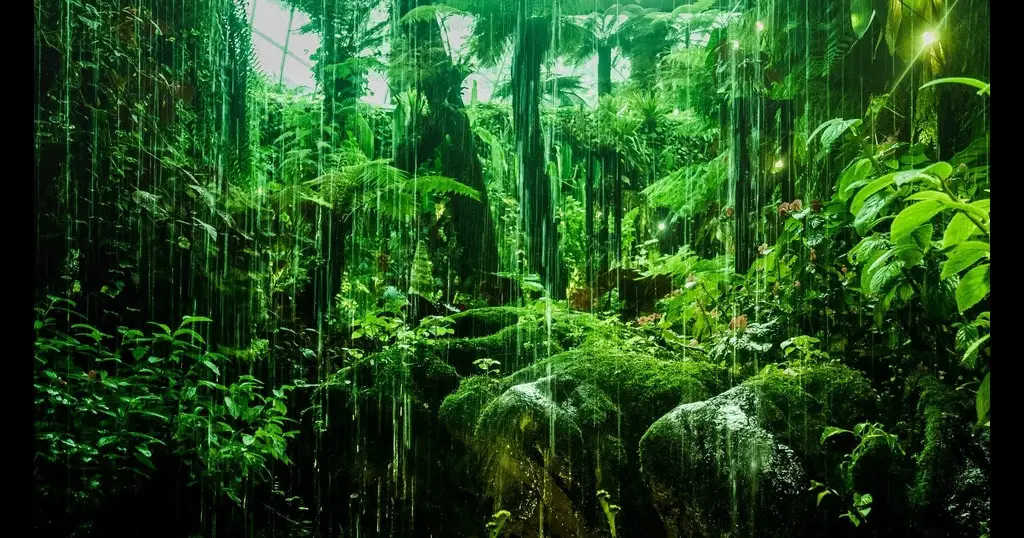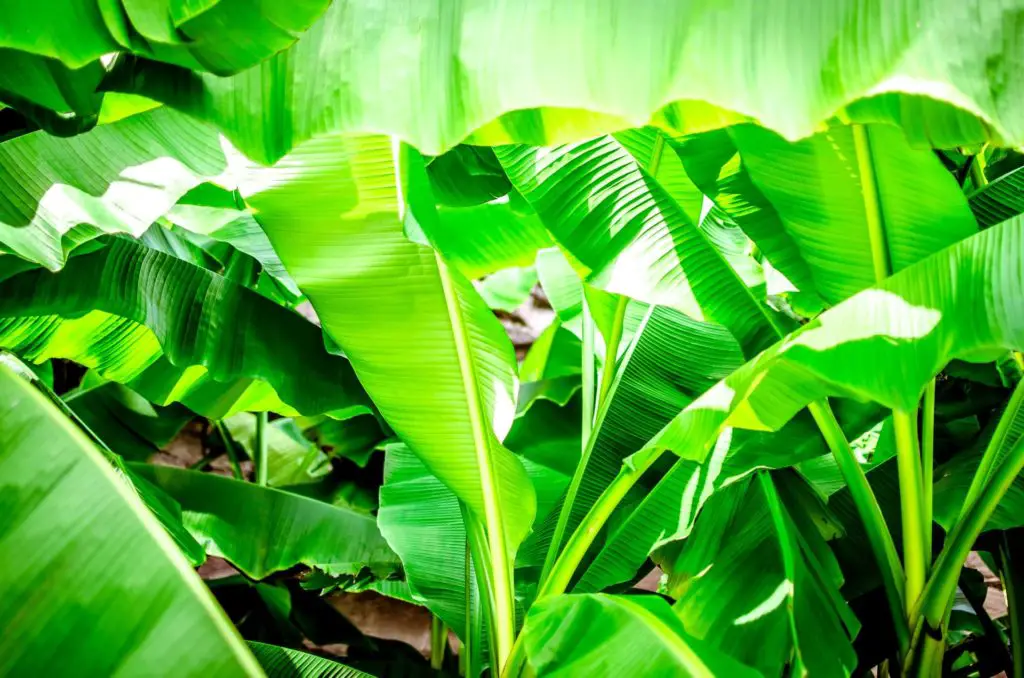The rainforest is home to more than two-thirds of the world’s plants. it is the most diversified biome in the world in terms of plant life.
The rainforest produces 20% of the world’s oxygen. As its name indicates, rainforests are forests with a high level of rainfall ( more than 100 inches of rain a year). Also, it has a warm climate.
The high level of warmth and rainfalls makes the atmosphere in the rainforest very humid.
Besides, that rainforest has poor soil. The plants in the rainforest have evolved to adapt to these unique conditions.
Plants structure the rainforest through four different layers. Each rainforest layer contains plants that to some extent share similar characteristics.
Rainforest plants layers
Emergent layer
The emergent layer consists of rainforest trees that reach 200 feet tall. Such trees receive the highest amount of sunlight in the forest.
But they should also be strong enough to stand the strong winds and storms.
Canopy layer
Rainforests are known for their close canopy. the canopy layer formed by different trees that around 100 feet tall.
Such trees receive enough sunlight and they are partly protected from winds by the emergent layer. Most rainforest plants and animals live in this layer.
Understory layer
This layer receives less than 15% of the sunlight which reaches the canopy layer. Therefore, it is dark and only supports plants that can live with a low amount of sunlight.
The plants that live in the understory layer have large leaves. Such leaves allow the plants to capture the maximum amount of sunlight to survive.
Most popular houseplants are native to the understory layer.
by understanding the nature and the conditions of this layer. It allows you to know what most houseplants need in order to thrive.

Forest floor
The rainforest floor is very dark and receives less than 2% of the sunlight that falls in the canopy layer. which makes it a hard place for plants to grow in.
For the rain to reach the rainforest floor it takes about 10 minutes. Can you imagine the density of the upper layers!
Moss and few plant species are living on the rainforest floor. Only the plants that can tolerate the extremely low amount of sunlight.
10 common rainforest plants
While rainforest is a home for more than two-thirds of the overall world plants. the below list is the most interesting rainforest plants:
1. Epiphytes
the rainforest is the natural home for the plants that grow without soil. As weird as it sounds epiphytes are plants that grow either on other plants (trees) or rocks.
Epiphytes get their moisture and nutrients from the air through their roots. they grow on trees. such tropical plants use trees only as host ( not a parasitic plant).
Epiphytes anchor themselves on trees through their roots. The roots serve two functions, absorbing nutrients and moisture from the air and sticking the plant in the host tree.
Such plants may take advantage of the decaying organic matter debris that can found in the tree bark cracks.
Some types of orchids that grow as epiphytes are native to the rainforest. Also, the beautiful air plants (Tillandsia) the houseplant that needs the least amount of maintenance are native to the rainforest.
Most epiphytes live in the understory rainforest layer.
2. Cocoa Tree
Next time you are eating chocolate bars or drinking hot chocolate. Rember the rainforest! cocoa trees are native to the rainforest.
They grow in the understory layer. The chocolate tree can reach from 15 to 25 feet tall. because it lives in the understory layer it tolerates a low amount of sunlight.
3. Rubber Tree
The rubber tree is native to the rainforests of the Amazon region. It can grow to reach 100 feet. Which makes it usually part of the canopy layer.
Also, the rubber tree is a fast-growing tree. it grows fast to fill the gaps in the canopy layer when other trees fall.
The tree has elastic sab that exists beneath the bark.
For a long time before the industrial revolution, native tropical rainforest’s people used the rubber tree’s sab to make waterproof clothes and footwear.
After the industrial revolution rubber sab used in making auto tires, surgical gloves, machinery, and other products.
4. Banana Tree
While the banana plant looks like a tree it is actually a giant herb. The banana trunk is not a one-piece solid wood.
It actually multiple leaves that tied together very closely. The banana tree is native to tropical rainforest.
It is ranked as the fourth crop that traded worldwide. it is almost known and consumed in every county. Banana is the number one fruit in the united states.
The high level of rainfall and the warmth make the rainforests the ideal place for the banana tree to grow in.

5. Tangarana Tree
If you had a walk in the tropical rainforests with an open eye. You will notice some trees that have real personal space.
No other plant can grow in their space. Those magnificent plants are tangarana trees. they have special bodyguards. Tangarana tree has a mutualistic relationship with fire ants.
The mutualistic relationship is a relationship between two species that benefit both parties. In the case of tangarana, the ants protect the tree from other insects.
And they also eat any plant that tries to grow in the tree’s space. There is a competition between plants in the sunlight, moisture, and nutrients.
Those ants kill any plants that came near to their tree. While tangarana tree returns the favor by providing the ants with the required food and shelter.
6. Devil’s Gardens
Same as tangarana tree, devil’s gardens have a mutualistic relationship with some kind of ants called lemon ants.
The plant provides the ants with nutrients and shelter. while the ants defend the plants from other insects and invading plants. They kill any plant try to grow near the devil’s gardens.
Actually, a lot of species have mutualistic relationships with other species. But this plant went further in the art of space domination.
It releases chemicals from its roots in the soil to prevent other plants from growing next to it. This is why it has the devil name.
7. Vines
There are more than 2500 vines species in the rainforest. Actually, 90% of world vines are native to the rainforest.
The rainforest vines serve the forest by intertwining forest trees together which makes them more stable and can stand the strong winds.
The vines that Tarzan uses in the famous movie as a way of transportation are typical rainforest vines.
Most rainforest vines grow from the rainforest canopy and send their roots down to the forest ground.
8. Pitcher plants
As much as there is a lot of beautiful plants in the rainforests. There are really weird ones. The pitcher plant is carnivorous.
Which means it eats meat. This weird plant resides in the rainforest with its strange shape that looks like an upside-down bell. The plant eats insects and little animals like rats and lizards.
Fortunately, it is not big enough to eat humans. Although such plants consume meat for nutrition. they still use light to make their food.
Pitcher plants use their nectar to attract their victims (insects and little animals). The nectar gland is near the plant’s mouth.
When insects try to get the plant’s nectar, the pitcher plant captures them and sends them through its upper inside part ( throat) to its lower part.
The plant’s lower part is full of liquid enzymes that break down and digest the prey.
After the prey is well digested the plant absorbs it as nutrients.
Pitcher plants and other carnivorous plants eat insect and small animals as adaption method to the poor soil in the rainforest.
9. Orchids
Orchid is the number one flowering plant in terms of species diversity. beautiful epiphytes orchids ( the ones that grow on other trees) are native to the rainforest.
They adapt very well to the rainforest conditions. funny fact is that orchids plants mimic other insects and shapes to attract and fool pollinators.
For example, some orchid type has flowers that look like some kind of female-bee.
The orchid fools the male-bee from the same bee species to ensure that it gets pollinated.
We wrote an article about how orchids live in the wild you can read it to know more about these beautiful and deceptive creatures.
10. Air plants (Tillandisia)
There are around 650 types of air plants in the rainforest. In modern days air plants have been a favorable option for internal designers and homeowners.
Because it demands low maintenance and care level. And at the same time, due to its special unique features, it gives the designers space for creativity.
It can grow at hanging ropes or any other host object that suit the home decoration. for more information about air plants and how you can use them as houseplants follow this link.
Air plants are one of the rainforest’s epiphytes that do not need soil as a growing medium. Similar to orchids. It gets moisture and nutrients from rainforest air through its strong roots.
Rainforest plants adaption
Rainforest has unique conditions such as poor soil, heavy rainfalls, high humidity, and steady warmth.
Those conditions led rainforest plants to develop special features that help them to adapt to the special conditions.
below are some of the adaption techniques:
A. Rainforest plants have drip tips
Most rainforest plants have drip tips that allow them to drain rainfalls quickly.
B. The plants in the rainforest have thin barks
Since rainforests are abundantly moist and full of rainfalls. The trees developed thin bark because there is no need to store water in their bark.
C. Many rainforest plants have supporting roots
The rainforest has poor soil. The nutrients are only found in the topsoil of the rainforest.
Therefore trees do not go deep into the ground. They only spread their roots through the surface soil. At the time, rainforest plants in order to get enough amount of sunlight they need to grow tall to reach the canopy layer.
Those needs led many rainforest trees to develop buttress roots (supporting roots). The supporting roots emerge from trees trunk to spread widely above the ground.
Such roots help the trees to capture extra nutrients in the soil surface and keep the tree well grounded.
Sometimes the roots of several trees intertwine to further ground the whole trees as a single unit.
Some rainforest plants grow without soil
The sunlight in the rainforest is a rare commodity. Only certain species can grow tall enough to reach sunlight.
Others should find their own ways to the sunlight. Many plant species in the rainforest in their pursuit of sunlight they adapt to grow high in other trees trunks and branches.
The host tree provides them with the right spot to get enough sunlight. And they develop roots that strong enough to stick them in the host tree.
And at the same time performs its primary function of absorbing moisture and nutrients. But instead of absorbing what it needs from the soil, it absorbs it from the air.
